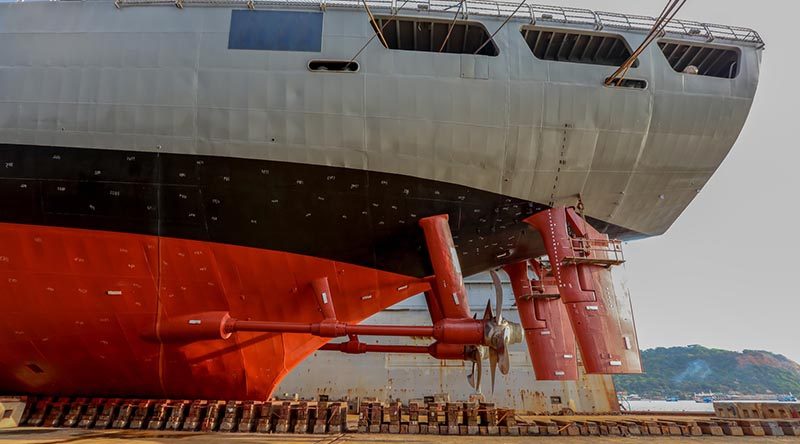When capability overrides supportability – project disappointment
Share the post "When capability overrides supportability – project disappointment"

Submitted ‘thought piece’…
(Image supplied by Beca)
When it comes to military procurement, acquisition leads often focus on buying as much operational capability as possible within a project budget. But new capabilities are irrelevant if your warship is tied up in port because it’s waiting on a spare. Beca Technical Fellow and former weapon engineering officer Bruce Neville discusses why we shouldn’t gloss over supportability issues when making defence procurement decisions.
An Aussie friend of mine recently bought a fancy car with run-flat tyres that you can still drive on for 80km after getting a flat. They’re a brilliant innovation with – as my friend discovered – one minor flaw. What happens if you get a flat in the middle of the bush? The local mechanic my friend managed to drive to laughed when he saw the tyres. “You won’t get spares around here mate.” The nearest dealer was a plane ride away.
My friend copped a lot of good-natured ribbing in the pub, but he’s in good company. His decision to buy an expensive yet unsupportable product is still replicated by military decision-makers around the world. As navies procure the latest vessels, weapons and systems, they don’t always give sufficient attention to basic, but critical questions:
- Are systems critical to a mission sufficiently reliable?
- What happens if a component in a mission critical system fails?
- What about failure in safety critical systems?
- Where do we get spares?
- Is it easy to fix? Or will we need an onshore specialist?
- How long will it take to train our crew to use and maintain it?
Ask anyone in naval procurement and they’ll tell you these things are always taken into account. But the reality is supportability is frequently trumped by performance considerations. Navies do a terrific job of buying things that perform well. But they don’t always buy things that perform well all of the time.
After spending 20 years as an engineer in the Royal New Zealand Navy, and another 20 consulting to defence organisations across Asia Pacific, I believe acquisition decisions should fundamentally be made on the basis of owning ‘economically supportable’ assets.
What are the characteristics of an economically supportable asset?
No matter what performance capabilities are on offer, navies should only buy assets that tick the following boxes:
- High levels of reliability or redundancy – Buy what you can make work – all of the time. There’s no point having the highest performing sensor capability if it breaks half-way through a surveillance mission and no one on board knows how to fix it. Mission critical systems either need to be highly reliable or come with several layers of redundancy.
- Effective supply chains locally and internationally – An adequate product with abundant spares and a global repair network is better than a stellar product that takes 18-months to get a spare and can only be repaired overseas, in the country of manufacture.
- Realistic repair routes – It’s embedded in your ship. Now it’s broken. Can you get it out to be repaired without dismantling half the ship?
- Upgradeability – Whatever you buy will need to change sooner than you planned for, particularly modern, software-based systems. Does your ship have sufficient space and spare capacity in key services? Are the systems of a modular design and easy to change or upgrade? Can you readily add more capabilities later when the new budget comes in?
- Commonality – Where it makes sense, new capabilities should support standardisation in fleet- or defence-wide systems, equipment and suppliers. That way, a sailor moving from ship to ship will be already trained to use and fix most of the systems. Commonality shouldn’t come at the expense of functionality – never use it as an excuse to perpetuate bad equipment. But don’t buy a radio that no one in the fleet knows how to work when you could have chosen a line-ball product that everyone’s familiar with.
- ‘Parent navy’ support – Unique assets, especially those with obscure systems and capabilities, will be a significant challenge for a small- to medium-sized navy to operate and support. Much larger navies can enjoy the benefits of scale and maintaining commonality with them can ease the burden of supportability. This approach naturally requires there to be alignment in operational doctrine and logistics support concepts.
Supportability optimises human resources
Supportability will be increasingly important as navies move towards hybrid sailors and small crews. If we’re developing more generalists than specialists, commonality of systems, high levels of redundancy, automation and effective repair networks will be critical elements of mission support.
Also, if we can spend less time teaching people to use and maintain equipment, more training time can focus on the mission itself.
When I hear defence procurement decision-makers claim that they a taking a balanced view of military capability, supportability and whole-of-life costs, my experience suggests that this is often not the case. Affordable supportability is often sacrificed for other factors. This then can result in delivered capability that fails to meet expectations. Perhaps it is time to re-orient procurement decisions around the fundamental question: Can we economically support this asset throughout its life?
Visit our website to learn more about what we do in Defence and how we can help you make smart procurement decisions.
.
.
.
.
.
.

.
.
Share the post "When capability overrides supportability – project disappointment"





